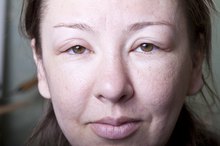What does fact checked mean?
At Healthfully, we strive to deliver objective content that is accurate and up-to-date. Our team periodically reviews articles in order to ensure content quality. The sources cited below consist of evidence from peer-reviewed journals, prominent medical organizations, academic associations, and government data.
The information contained on this site is for informational purposes only, and should not be used as a substitute for the advice of a professional health care provider. Please check with the appropriate physician regarding health questions and concerns. Although we strive to deliver accurate and up-to-date information, no guarantee to that effect is made.
What Are the Causes of Swollen Eyes & Face?
Swelling of the eyelids and the surrounding tissue may cause alarm, particularly if the eyelids swell shut or the person experiences significant pain. While waiting for a medical evaluation, a person with swelling may wish to hold a cool compress against the affected areas to reduce discomfort. Treatment may vary depending on the cause for the symptoms. Knowing some of the causes for swelling of the eyelids and face may help determine necessary treatment.
Allergies
Eye allergies may cause a person to experience swelling around the eyes, explains The University of Michigan Kellogg Eye Center 1. If a person has severe allergies to foods and other triggers, the person’s face may swell as well. Typically, food allergies result in localized swelling around the lips and cheeks, but some people may experience significant swelling around the entire face. Allergy eye drops may reduce eyelid swelling, but allergy medications may help with overall improvement. If a person with swelling experiences difficulty in breathing, she should seek emergency medical attention.
- Eye allergies may cause a person to experience swelling around the eyes, explains The University of Michigan Kellogg Eye Center 1.
- If a person has severe allergies to foods and other triggers, the person’s face may swell as well.
Angioedema
What Causes Edema Above the Eyes?
Learn More
Swelling of the face typically appears around the eyes and lips. Angioedema causes swelling just under the skin that may form “welts” on the top layer of skin 2. In some people, angioedema may stem from an allergic reaction, but other situations may trigger the condition as well 2. A person may have angioedema after an infection or as a result of conditions such as lupus and leukemia, explains MedlinePlus 2. For some people, doctors may not know the cause for the swelling. A mild case of angioedema may clear on its own, without treatment 2. Allergy medications often help reduce swelling. If a person experiences breathing problems, the situation requires immediate medical care.
- Swelling of the face typically appears around the eyes and lips.
- Angioedema causes swelling just under the skin that may form “welts” on the top layer of skin 2.
Orbital Cellulitis
An infection of the tissues around and behind the eye may cause swelling around the eye and toward the cheek. This condition, called orbital cellulitis, poses a serious threat to the patient since the infection may spread. The muscles responsible for eye movement may also have swelling, and this may result in difficulty or severe pain with eye movement. Orbital cellulitis requires immediate medical care, and most patients with the condition require hospitalization. The doctor typically use IV antibiotics to treat the infection, and, in severe cases, a doctor may recommend surgical drainage of any abscesses.
- An infection of the tissues around and behind the eye may cause swelling around the eye and toward the cheek.
- The doctor typically use IV antibiotics to treat the infection, and, in severe cases, a doctor may recommend surgical drainage of any abscesses.
Related Articles
References
- The University of Michigan Kellogg Eye Center: Allergies of the Eye
- MedlinePlus: Angioedema
- Tarbox JA, Bansal A, Peiris AN. Angioedema. JAMA. 2018;319(19):2054. doi:10.1001/jama.2018.4860
- Banerji A, Sheffer AL. The spectrum of chronic angioedema. Allergy Asthma Proc. 2009;30(1):11-6. doi:10.2500/aap.2009.30.3188
- Bork K. Recurrent angioedema and the threat of asphyxiation. Dtsch Arztebl Int. 2010;107(23):408-14. doi:10.3238/arztebl.2010.0408
- Bernstein JA, Cremonesi P, Hoffmann TK, Hollingsworth J. Angioedema in the emergency department: a practical guide to differential diagnosis and management. Int J Emerg Med. 2017 Dec;10(1):15. doi: 10.1186/s12245-017-0141-z. Epub 2017 Apr 13.
- Gill P, Betschel SD. The Clinical Evaluation of Angioedema. Immunol Allergy Clin North Am. 2017 Aug;37(3):449-466. doi: 10.1016/j.iac.2017.04.007.
Writer Bio
Kate Beck started writing for online publications in 2005. She worked as a certified ophthalmic technician for 10 years before returning to school to earn a Masters of Fine Arts degree in writing. Beck is currently putting the finishing touches on a novel.








